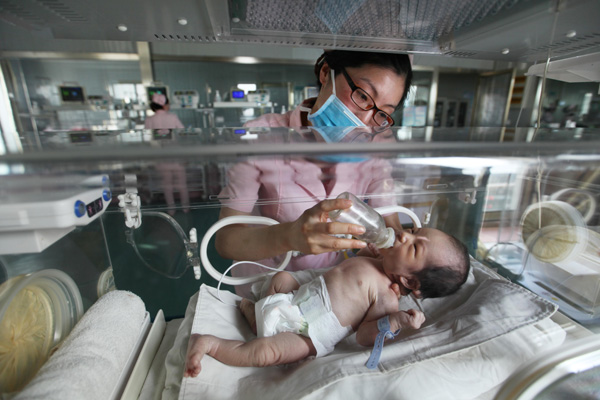Population outflow affects NE China's economic recovery
- By Li Shen
 0 Comment(s)
0 Comment(s) Print
Print E-mail China.org.cn, July 16, 2015
E-mail China.org.cn, July 16, 2015
|
A newborn is cared for in an incubator. The birth rates in China's northeast region is far below the national average rate and even lower than those in Japan and South Korea. [Photo: China Daily] |
An increased population outflow, low birth rate and the aging society in northeast China have affected the regional economic recovery and set off alarms about a potential population crisis.
Population outflux
Statistics from the Sixth National Population Census show that more than four million people had migrated outwards from northeast China, which includes Liaoning, Jilin and Heilongjiang provinces, by 2010. The net outflow of population in the region has reached 1.8 million whereas the net inflow of population in the region was 360,000 in 2000.
Some scholars believe that regional economic decline has drained out the local population. All three provinces ranked among the bottom five provinces in China for provincial GDP growth in 2014. Their average growth rate was slower than those in the middle, the western and the eastern regions.
Feng Lei, a researcher with the Institute of World Economics and Politics of Chinese Academy of Social Sciences, says that the regional industrial structure suffered a great impact from the fall in international bulk commodity prices and the domestic investment decline because all three provinces have manufacturing, petrolchemical and primary agricultural products as their pillar industries.
However, the outflow of young people has further worsened economic recovery. According to statistics from the Sixth National Population Census, most of the outflow population from northeast China comes from the young and middle-aged workforce. Most of them have migrated to developed areas like Beijing, Tianjin, Hebei and Shandong provinces. Wang Xiaofeng, a professor with the College of Northeast Asia Studies of Jilin University, observes that population growth in border areas in northeast China is sluggish. Negative growth even appears. The depopulation has caused a constitutive lack of labor in the region.
Yi Fuxian, a population expert at the University of Wisconsin, echoed Wang's observation. Citing the examples from Japan and Germany, Yi said that the negative growth of the workforce would lead to an economic slowdown and structural imbalance which would result in increased unemployment. On one hand, the lack of labor is getting worse, and on the other hand the jobless rate will keep increasing. Yi thinks that labor shortage and low employment will coexist for a long time.
Low birth rate
The birth rates in Liaoning, Jilin and Heilongjiang provinces are 1.03 percent, 1.03 percent and 1.0 percent respectively, far below the national average rate of 1.5 percent and even lower than those in Japan and South Korea. According to international criteria, a birth rate which is below 1.3 percent is defined as an ultra-low birth rate.
On April 22, 2014, Heilongjiang Province implemented its new second-child policy which allows couples to have two children as long as one of them is from a single-child household. Only 1.6 percent of the qualified spouses have obtained the second-child certificate so far, lower than the national average rate of 8.3 percent.







Go to Forum >>0 Comment(s)